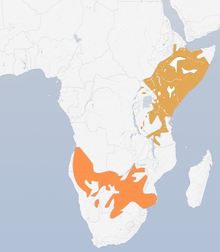Eurocephalus
| Eurocephalus | |
|---|---|

| |
| Southern white-crowned shrike (Eurocephalus anguitimens) | |
| Scientific classification | |
| Domain: | Eukaryota |
| Kingdom: | Animalia |
| Phylum: | Chordata |
| Class: | Aves |
| Order: | Passeriformes |
| Family: | Laniidae |
| Genus: | Eurocephalus A. Smith, 1836 |
| Type species | |
| Eurocephalus anguitimens A. Smith, 1836
| |
| Species | |
| |

| |
Eurocephalus is a small genus of passerine birds containing two species commonly known as white-crowned shrikes.
Extant Species
[edit]| Image | Scientific name | Common Name | Distribution |
|---|---|---|---|
 |
Eurocephalus ruppelli | Northern white-crowned shrike or white-rumped shrike | east Africa from south eastern South Sudan and southern Ethiopia to Tanzania |
 |
Eurocephalus anguitimens | Southern white-crowned shrike or white-crowned shrike | Angola, Botswana, Mozambique, Namibia, South Africa, and Zimbabwe. |
Description
[edit]The white-crowned shrikes are large brown and white shrikes found in sub-Saharan Africa. They are gregarious species, unlike the Lanius shrikes, and have a parrot-like flight.
Eurocephalus shrikes are birds of savanna and open woodland habitats, typically seen perched upright on a prominent thornbush perch. These species primarily take large insects, but will occasionally eat fruit which has fallen to the ground.
The male and female are similar in plumage in both species but are distinguishable from immature birds.
Taxonomy
[edit]The genus Eurocephalus was introduced in 1836 by the zoologist Andrew Smith to accommodate a single species, the southern white-crowned shrike. He placed the genus in the crow family Corvidae.[1] It was later transferred to the shrike family Laniidae.[2]
A recent analysis of their phylogenetic relationships using molecular markers found them more closely related to the crows than the shrikes and suggested they be placed in a new family, Eurocephalidae.[2] This placement was supported by morphological characteristics, their specialised dietary niche and their cooperative breeding.[2]
References
[edit]- ^ Smith, Andrew (1836). Report of the Expedition for Exploring Central Africa, from the Cape of Good Hope, June 23, 1834, Under the Superintendence of Dr. A. Smith. Cape Town: Printed at the Government Gazette Office. p. 52.
- ^ a b c McCullough, Jenna M.; Hruska, Jack P.; Oliveros, Carl H.; Moyle, Robert G.; Andersen, Michael J. (2023). "Ultraconserved elements support the elevation of a new avian family, Eurocephalidae, the white-crowned shrikes". Ornithology. 140 (3): ukad025. doi:10.1093/ornithology/ukad025.
- Tony Harris and Kim Franklin, Shrikes and Bush-Shrikes ISBN 0-7136-3861-3








